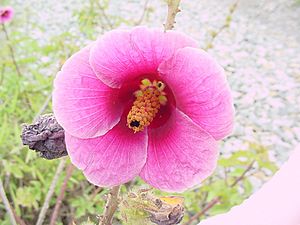Striped hibiscus facts for kids
Quick facts for kids Striped hibiscus |
|
|---|---|
 |
|
| Scientific classification | |
| Genus: |
Hibiscus
|
| Species: |
striatus
|
Hibiscus striatus, also known as the striped hibiscus or striped rosemallow, is a beautiful flowering plant. It belongs to the mallow family, called Malvaceae. This family includes many well-known plants like cotton and okra. The flowers of the striped hibiscus are quite large, often growing up to 5 inches (about 12.7 cm) wide. They are some of the biggest flowers you'll find in the mallow family!
Contents
What is the Striped Hibiscus?
The striped hibiscus is a type of plant known for its striking flowers. These flowers often have delicate stripes, which is how the plant gets its name. It's a popular plant in gardens because of its beauty and large blooms.
Where Does Striped Hibiscus Grow?
The striped hibiscus is native to parts of South America. You can find it growing naturally in countries like Brazil, Argentina, and Uruguay. It prefers warm climates and often grows near water, like along riverbanks or in wetlands. This plant loves sunny spots and well-drained soil to thrive.
What Does a Striped Hibiscus Look Like?
The striped hibiscus plant can grow as a shrub or a small tree. It usually reaches a height of about 3 to 6 feet (around 1 to 2 meters). Its leaves are green and can be lobed, meaning they have rounded sections, or they can be more oval-shaped.
The Beautiful Flowers
The most eye-catching part of the striped hibiscus is its flowers. They are typically light pink or white with darker pink or red stripes. These stripes often radiate from the center of the flower, creating a lovely pattern. Each flower has five petals that open wide, showing off their beauty. The center of the flower has a prominent column with pollen-producing parts.
Life Cycle and Reproduction
Like many flowering plants, the striped hibiscus goes through a fascinating life cycle. It starts from a seed, grows into a plant, produces flowers, and then makes more seeds.
How Does Striped Hibiscus Reproduce?
The striped hibiscus reproduces using its flowers. The bright colors and large size of the flowers attract pollinators like bees and butterflies. When these insects visit the flowers to collect nectar, they also pick up pollen. As they move from one flower to another, they transfer pollen, which helps the plant create seeds.
From Flower to Seed
After a flower is pollinated, it develops a seed pod. Inside this pod, tiny seeds grow. Once the seeds are mature, the pod opens, releasing them. These seeds can then fall to the ground or be carried by wind or water to new locations. If the conditions are right, a new striped hibiscus plant will grow from these seeds, continuing the life cycle.
Caring for Striped Hibiscus
If you want to grow a striped hibiscus, it's good to know what it needs. These plants are relatively easy to care for, especially in the right climate.
What Does Striped Hibiscus Need to Grow?
Striped hibiscus plants love sunlight. They need at least six hours of direct sun each day to produce lots of flowers. They also prefer soil that drains well, meaning water doesn't sit around the roots for too long. Regular watering is important, especially when the plant is young or during dry periods.
Pruning for Health
Sometimes, gardeners will prune, or trim, their striped hibiscus plants. This helps the plant grow bushier and produce more flowers. Pruning also removes any old or damaged branches, keeping the plant healthy and strong.
Images for kids


